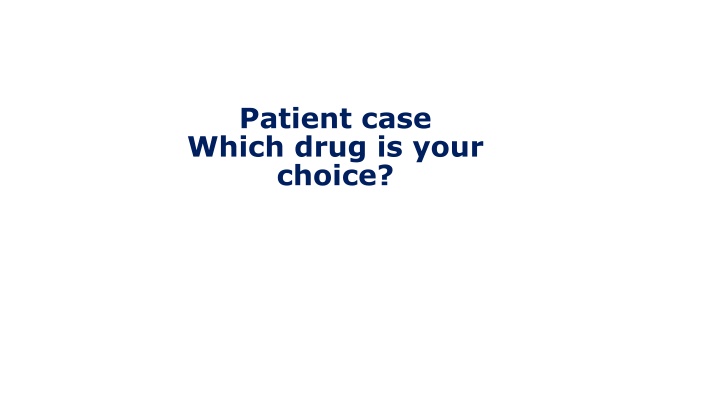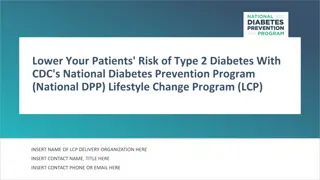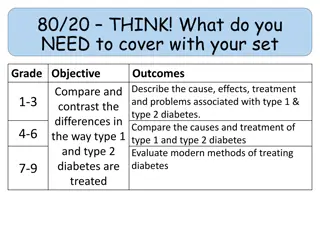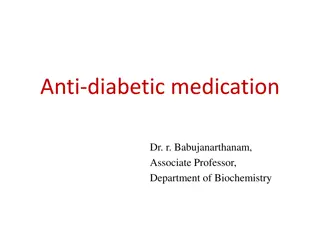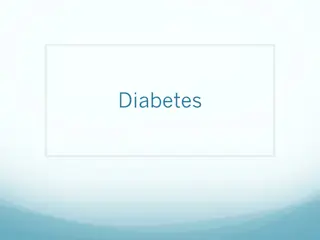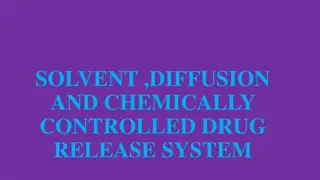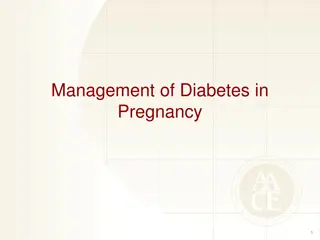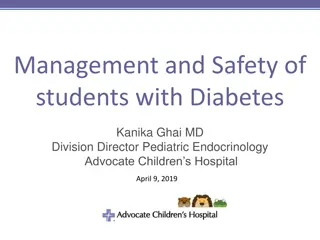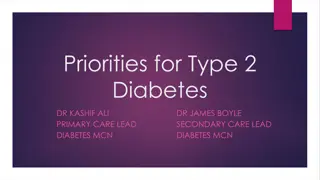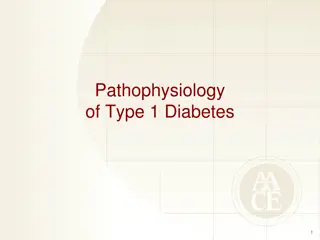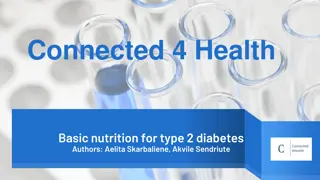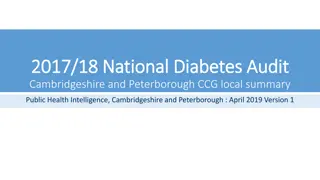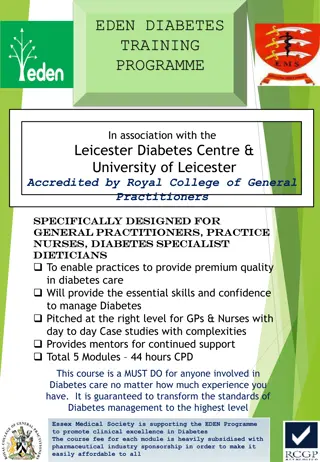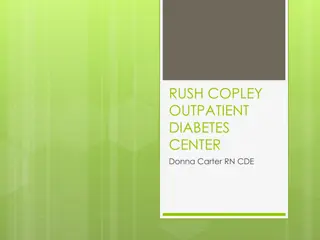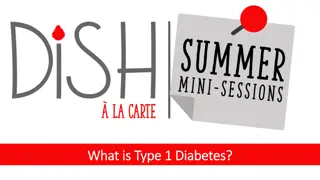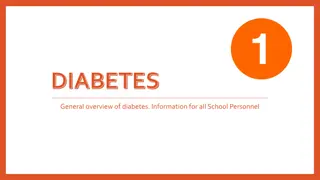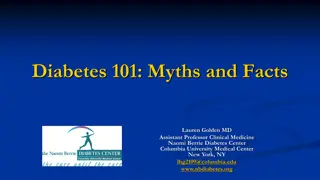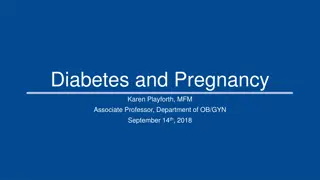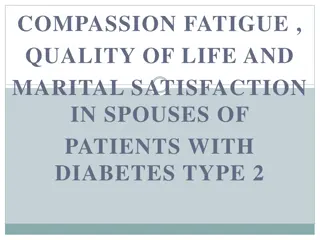Patient Case: Treatment Options for Poorly Controlled Type 2 Diabetes
In this patient case, a sales representative with poorly controlled type 2 diabetes is struggling to manage his glycemia effectively. High cholesterol, macroalbuminuria, and moderate kidney disease further complicate his condition. Explore treatment options such as DPP-4 inhibitors, SGLT2 inhibitors, and GLP-1 receptor agonists to improve his HbA1c levels. Follow-up visits with changes in medication reflect the ongoing challenges in achieving glycemic targets and addressing comorbidities. Consider patient factors, like occupation and lifestyle, when selecting the most suitable treatment strategies.
Download Presentation

Please find below an Image/Link to download the presentation.
The content on the website is provided AS IS for your information and personal use only. It may not be sold, licensed, or shared on other websites without obtaining consent from the author.If you encounter any issues during the download, it is possible that the publisher has removed the file from their server.
You are allowed to download the files provided on this website for personal or commercial use, subject to the condition that they are used lawfully. All files are the property of their respective owners.
The content on the website is provided AS IS for your information and personal use only. It may not be sold, licensed, or shared on other websites without obtaining consent from the author.
E N D
Presentation Transcript
Patient case Which drug is your choice?
2 Patient case Initial visit 183 mg/dL (10.2 mmol/L) 229 mg/dL (12.7 mmol/L) eGFR: 48 mL/min/1.73 m2 FPG: Urinary albumin excretion: Age: 324 mg/24h 54 years PPG: Family history of diabetes: Occupation: No emloyer 137 mm Hg Systolic BP: T2D duration: None 6 years Alcohol intake: 78 mm Hg Diastolic BP: 8.7% (71.6 mmol/mol) 257 mg/dL (6.6 mmol/L) HbA1c : Total cholesterol: Non-smoker Smoking: HDL cholesterol:48 mg/dL Exercise: Weight: Little 108.9 kg (1.2 mmol/L) LDL cholesterol:174 mg/dL BMI: 31.7 kg/m2 Lifestyle modifications 2000 mg metformin OD 100 mg Lozartan OD Treatment summary: (4.5 mmol/L) Notes: He is busy and finds it difficult to eat well and exercise regularly. He was diagnosed with T2D 6 years ago, and his glycaemia is not well controlled. At his recent appointment, his blood test showed high cholesterol and urinalysis demonstrated macroalbuminuria. Subsequent testing revealed moderate kidney disease. Given his occupation as a sales representative, he is not a good candidate for insulin therapy due to the danger of hypoglyacemia. 2 BMI, body mass index; eGFR, estimated glomerular filtration rate; FPG, fasting plasma glucose; HDL, high-density lipoprotein; LDL, low-density lipoprotein; OD, once-daily; PPG, postprandial glucose
UKPDS risk factor Consider CV risk when selecting a treatment option
How would you improve HbA1c for him? Consider DPP-4 inhibitor 1 Consider SGLT2 inhibitor Consider SGLT2 inhibitor 2 Consider GLP-1RA Consider GLP-1RA 3 GLP-1, glucagon-like peptide-1 receptor agonist; SGLT2, sodium glucose co-tranporter-2
5 Patient case: He was on sitagliptin Follow-up visit 153 mg/dL (8.5 mmol/L) 182 mg/dL (10.1 mmol/L) eGFR: 48 mL/min/1.73 m2 FPG: Urinary albumin excretion: Age: 335 mg/24h 54 years PPG: Family history of diabetes: Occupation: No employee 134 mm Hg Systolic BP: T2D duration: None 6 years Alcohol intake: 77 mm Hg Diastolic BP: 7.7% (60.7 mmol/mol) 151 mg/dL (3.9 mmol/L) HbA1c : Total cholesterol: Non-smoker Smoking: HDL cholesterol:56 mg/dL Exercise: Weight: Little 106.4 kg (1.4 mmol/L) (4.5 mmol/L) LDL cholesterol:174 mg/dL BMI: Lifestyle modifications 2000 mg metformin OD 16 mg candesartan OD 50 mg sitagliptin 30.9 kg/m2 Treatment summary: Notes: 3 months since previous visit Although glycaemic control improved, he did not reach his glycaemic target No clinically relevant changes to eGFR, body weight or cholesterol 5 BMI, body mass index; eGFR, estimated glomerular filtration rate; FPG, fasting plasma glucose; HDL, high-density lipoprotein; LDL, low-density lipoprotein; OD, once-daily; PPG, postprandial glucose
6 Patient case: on empagliflozin Follow up visit 135 mg/dL (7.5 mmol/L) 176 mg/dL (9.8 mmol/L) eGFR: 48 mL/min/1.73 m2 FPG: Urinary albumin excretion: Age: 200 mg/24h 54 years PPG: Family history of diabetes: Occupation: No employee 127 mm Hg Systolic BP: T2D duration: None 6 years Alcohol intake: 73 mm Hg Diastolic BP: 7.5% (58.5 mmol/mol) 251 mg/dL (6.4 mmol/L) HbA1c : Total cholesterol: Non-smoker Smoking: HDL cholesterol:56 mg/dL Exercise: Weight: Little 105.0 kg (1.4 mmol/L) (4.4 mmol/L) LDL cholesterol:174 mg/dL BMI: Lifestyle modifications 2000 mg metformin OD 100 mg Losartan OD 10 mg empagliflozin 31.1 kg/m2 Treatment summary: Notes: Two months since previous visit Although glycaemic control improved, he did not reach his glycaemic target Substantial improvement in eGFR, proteinuria and blood pressure No clinically relevant changes to body weight or cholesterol Frequent urination from empagliflozin is inconvenient due to his occupation as a truck driver 6 BMI, body mass index; eGFR, estimated glomerular filtration rate; FPG, fasting plasma glucose; HDL, high-density lipoprotein; LDL, low-density lipoprotein; OD, once-daily; PPG, postprandial glucose
Consider liraglutide: clearance of GLP-1RAs Elimination route Similar to large proteins no specific organ identified Liraglutide Exenatide ER Predominantly renal Exenatide Predominantly renal Lixisenatide Predominantly renal Dulaglutide General protein catabolism ER, extended release; GLP-1RA, glucagon-like peptide-1 receptor agonist
8 Patient case: on liraglutide Follow-up visit 101 mg/dL (5.6 mmol/L) 148 mg/dL (8.2 mmol/L) eGFR: 48 mL/min/1.73 m2 FPG: Urinary albumin excretion: Age: 201 mg/24h 54 years PPG: Family history of diabetes: Occupation: No employee 120 mm Hg Systolic BP: T2D duration: None 6 years Alcohol intake: 70 mm Hg Diastolic BP: 6.8% (50.8 mmol/mol) 237 mg/dL (6.1 mmol/L) HbA1c : Total cholesterol: Non-smoker Smoking: HDL cholesterol:48 mg/dL Exercise: Weight: Little 98.4 kg (1.2 mmol/L) (4.6 mmol/L) LDL cholesterol:177 mg/dL BMI: 28.6 kg/m2 Treatment summary: Lifestyle modifications 2000 mg metformin OD 100 mg Losartan OD 1.8 mg liraglutide Notes: Four weeks since previous visit He has reached his glycaemic target and shows substantial improvements in body weight and blood pressure, and moderate improvements in cholesterol No clinically relevant change in renal function Treatment with liraglutide results in little risk of hypoglycaemia 8 BMI, body mass index; eGFR, estimated glomerular filtration rate; FPG, fasting plasma glucose; HDL, high-density lipoprotein; LDL, low-density lipoprotein; OD, once-daily; PPG, postprandial glucose
